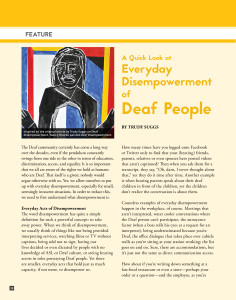 Video description: Trudy, a white woman with shoulder-length brown hair, is wearing a navy blue shirt with a red, white, light blue, tan, and navy blue striped scarf. She is seated in the corner with brown bookshelves on her right and a sea blue wall on her left.
Video description: Trudy, a white woman with shoulder-length brown hair, is wearing a navy blue shirt with a red, white, light blue, tan, and navy blue striped scarf. She is seated in the corner with brown bookshelves on her right and a sea blue wall on her left.
Image descriptions: The first image shows a white man with a graying beard in front of what appears to be a lake. He is wearing a white t-shirt with a black pen clipped onto his collar from under his shirt. Smiling broadly, his mirrored sunglasses show the reflection of the photographer. The next image is a screenshot of the number of shares, comments, and likes for Ronnie’s video.
Late in the evening on Friday, May 6, I watched a video by a friend, Renee, sharing how upset she was about another video she saw. Of course, I checked this other video out to see what she was talking about — and became equally troubled. I’ve been thinking about it all weekend and will continue thinking about it for a long time to come.
On Friday (or late Thursday night) at 3:07 a.m., Ronnie Craft of Virginia posted a video on his Facebook page. He stated he was upset about his girlfriend’s infidelity and the man “bothering” his girlfriend. Behind him was what appeared to be a rifle or shotgun of some sort, although it could very well have been a pipe. After he shared his hurt and anger, he said he would be dead the next morning.
Ronnie indeed committed suicide that morning, just as he had threatened. Although the video has since been removed, it stayed on his page for several days — and the comments continued even after the confirmation of his passing. One person, a couple of days after the video, posted that Ronnie was a “f**ktard” just trying to get attention and that we shouldn’t give him any.
 That wasn’t the most troubling thing about the video, though. What stunned my friend Renee, and me, was that at least 83 people shared the video on their Facebook pages. Although the comments showed that people did try to get help for Ronnie, there were also four people who clicked “like.” This is where social media sometimes gets confusing: many people will click “like” as a way of showing empathy. Even so, anytime someones makes a threat to harm himself or someone else, we must always choose immediate safety.
That wasn’t the most troubling thing about the video, though. What stunned my friend Renee, and me, was that at least 83 people shared the video on their Facebook pages. Although the comments showed that people did try to get help for Ronnie, there were also four people who clicked “like.” This is where social media sometimes gets confusing: many people will click “like” as a way of showing empathy. Even so, anytime someones makes a threat to harm himself or someone else, we must always choose immediate safety.
I have never met Ronnie, nor will I ever have the opportunity to. As I watched his video, my heart ached at his hurt and anger. I was even more disturbed by the response (especially the shares), trying to understand why they would do such a thing. Have we really become so immune to online “drama” that we simply repost angry and hurt videos to revel in people’s emotions? Is it worse to watch a video like this and say nothing? I saw the video far too late; had I seen it in time, I would have immediately contacted area authorities, especially since his post showed his location.
Suicide is not a rare act. According to dosomething.org, nearly 30,000 Americans commit suicide every year. This doesn’t include attempted suicide; each suicide represents 25 attempts. The website also says that one person commits suicide every 16.2 minutes on the average, and over 50% are committed with a firearm. These are eye-opening numbers. So why is there still such a stigma accompanying suicide? Aside from historical and religious teachings that identify suicide as a sin, it may be because we get worked up about the aftermath of a suicide and all the people left behind. Or it could be because we’re angry we didn’t help the person in time. Maybe the suicide hits too close to home, or we think the person is crazy to even consider death.
I’ve lost quite a few people to suicide over the years, and there’s a common thread that I see in each and every suicide: people saying that it is such a selfish act. While it may seem selfish to the people left behind, it isn’t selfish for the person committing it. Rather, it’s a final act of desperation to stop the intense, searing pain of hurt and anger. This suicide risk is heightened among people not fully aware of the tools for dealing with of depression, hopelessness, and pain. Add to that the fact that there is a severe lack of access to mental health services for deaf people, and it’s a volatile matter.
Back in 2005, I wrote about a friend who attempted suicide:
She changed her mind in the process, and decided to call local suicide resources to try and get some help. Nine of the ten places hung up immediately when they heard that it was a relay call. The tenth one said, “We don’t provide interpreters,” and hung up before my friend even said a word. Eventually, she found a friend to confide in, but still needs counseling services that are American Sign Language (ASL) accessible.
Another friend had suicidal thoughts several years ago. When I drove him to the hospital at his request, he was sent home after an overnight stay because they didn’t have the appropriate services. The interpreters sent for this assignment all knew my friend through work. My friend was embarrassed and frustrated, and to date, has never gotten the counseling and help he wants.
Meanwhile, until better alternatives are developed, people like my friends will continue wrestling with their emotional and mental needs, and feeling desolate and dismal about recovering from their emotional/mental pain. The Deaf community cannot let this go on anymore. We need to have mental health services immediately available and accessible for Deaf people in ASL with no rescheduling, no delay, and no cultural barriers. Read the full article here.
It’s been 20 years since these incidents, and little seems to have changed. Today we have counselors such as the Deaf Counseling Center with deaf licensed therapists specializing in services to Deaf people, but they are few and far in between. More and more therapists are providing services via videophones or via email, but that’s not the same as face-to-face services.
At 3:07 a.m. on May 6, when Ronnie Craft posted his video, he certainly could have called a hotline using video relay services. Yet would the hotline worker have understood what Ronnie was dealing with? Would the video interpreter have the skills to interpret this call? The scrutiny found within the close-knit deaf community, the language barriers, and all the cultural differences? Probably not.
Let’s go back to people’s sick fascination with online drama, especially suicide. What can we do to change this? I don’t know. Suicide is such a hot button, and can set off a lot of negative reactions from people, deaf or hearing. But get this: suicide is never a joke, and should never be taken lightly. If ever we can get rid of the stigma attached to suicide and stop being such jerks online, maybe we can learn how to help people feeling desolate and hurt. It’s often misstated that people who really want to commit suicide often will do it without calling attention to themselves, so those who post public comments, videos, or letters are simply “attention whores.”
Here’s the thing. It doesn’t matter if someone is trying to get attention by threatening suicide; we need to pay attention every single time. Even if a person is threatening suicide just for the sake of getting attention, that itself shows the person needs help. Anyone threatening suicide — seriously or jokingly — must be taken seriously at all times, and respected.
This article cannot be copied, reproduced, or redistributed without the written consent of the author.
 This article originally appeared in the Spring 2016 issue of NADmag;
This article originally appeared in the Spring 2016 issue of NADmag;